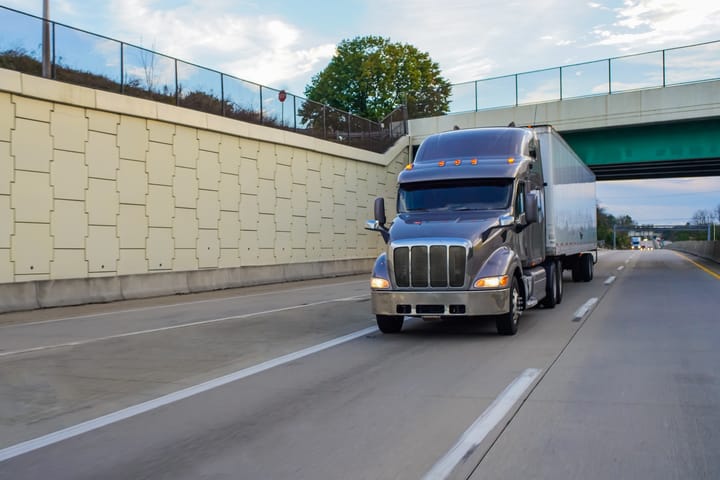Small fleets adapt
Plus: Truck parking troubles | Driver, 91, chasing dreams

The trucking industry is stuck in the “messy middle” of shifting to alternative powertrains—caught between emerging tech and real-world constraints. At the same time, fleets are under pressure to attract and retain drivers who expect more from the job: better tech, more flexibility, and improved work-life balance.
This week, we look at how companies are responding, from privacy concerns around in-cab cameras to the growing role of AI behind the wheel. We also break down key policy developments, like new driver tax incentives and truck parking proposals.
And we’re bringing the human stories too—a 91-year-old driver who is chasing dreams to the legal ripple effects of a major crash case. Let's get rolling.

⬆️ $3.592
AVG. COST OF DIESEL PER GALLON IN U.S. AS OF 3/31, UP 0.025¢
Source: U.S. Energy Information Administration

Small fleets stay scrappy as freight volatility lingers
David Spencer, VP of Market Intelligence, and Blair Blake, VP of Carrier Strategy at Arrive Logistics, break down the freight market from two key angles: Spencer tracks market cycles and rate trends, while Blake focuses on how carriers—especially small fleets—navigate shifting conditions. They sat down with The Inside Lane to discuss whether a freight rebound is coming, what’s driving market volatility and how small trucking businesses can stay ahead. -Shefali Kapadia
We keep hearing that an end to the freight recession is imminent. Do you see that happening?
Spencer: The freight market is cyclical, so rates will eventually increase again, but I do not believe there is an imminent inflection point capable of triggering a sustained inflationary period. Capacity has contracted significantly and is now more susceptible to demand shocks, but uncertainty remains as to where such demand growth will come from. For now, all we are seeing is greater volatility around typical seasonal demand surges in the summer and winter.
Are there any economic/market factors that might affect the freight market and the ability for rates to rise?
Spencer: A lower truckload rate environment will continue to put pressure on carriers to size their networks for optimal asset utilization, further exposing the market to disruption in the event of a demand shock. One key factor we’re monitoring for its potential impact on demand is greater clarity around U.S. tariff and tax policies. Additionally, if a recession occurs, it would likely drive rates down in the short term. However, the resulting capacity reduction could create a stronger upside when the economy eventually returns to growth.
How are small fleets positioned in the current market? Better or worse off than larger fleets and why?
Blake: Smaller fleets face ongoing challenges today as demand softens and tariff uncertainties persist. Because most participate in the market transactionally, events like the recent $0.12 month-over-month drop in dry van truckload spot rates increase competition and put pressure on margins. Larger fleets, on the other hand, can negotiate fuel and maintenance discounts to control costs, enabling them to offer more competitive contract freight pricing, which, in turn, locks in revenue and supports driver retention during inflationary periods. Despite these hurdles, smaller fleets remain resilient and adaptable, allowing them to pivot with market shifts and offer creative, flexible solutions that deliver value.
What's your No. 1 piece of advice to small business trucking owners operating in today's market?
Blake: Building and maintaining relationships is essential throughout market cycles. Relying solely on apps and load boards creates daily uncertainty. A blended approach, like Arrive’s Co-Pilot model, offers flexibility to choose loads based on a carrier’s unique strategy while reducing deadhead and enhancing cost control through efficiency solutions and matching technology.

Is the “messy middle” an opportunity for positive change?
The trucking industry is deep in the “messy middle” of transitioning to alternative powertrains—stuck between aging diesel fleets and the promise of cleaner, more efficient technologies. Pressures to cut emissions and improve sustainability are growing, but the path forward is anything but simple.
Michael Roeth, executive director of the North American Council for Freight Efficiency, breaks down what’s at stake: high upfront costs, uncertain infrastructure, and a wave of emerging tech that could either accelerate progress or stall it.
This transition is forcing fleets to rethink long-term strategies and make tough calls on where to invest. But it’s also a chance to gain an edge—those who move smartly could lower operating costs and improve their environmental footprint.
Why this matters: The shift towards alternative powertrains will significantly impact operational costs, infrastructure requirements and long-term business strategies. Understanding the different alternative powertrain options is essential for making informed investments and staying competitive.
Get more details at Fleetowner.com

RISKY BUSINESS: Professor studies how life on the road impacts health
A HOUSE DIVIDED: Controversy lingers around increasing truck weight limits
BUCKEYE BUY: Buckeye Career Center will acquire truck driving school
TRUCKIN’ PUP: Dog enjoys final joy-filled weekend of truck rides

"Trucking is not something that's going to be on the up and up at any given time. It's something you have to be resilient with. You have to expect problems and you have to adapt to that harsh environment."
While still in college, Andrew Gomez started AJG Transport, which has grown to an 80-truck operation generating over $1 million a month in revenue. He shares the key moves that fueled his rapid growth, the sacrifices he made, and the mistakes he learned from along the way.

Crash survivor alleges negligence by Amazon, ZBN Transport in $100M lawsuit
A survivor of a 19-vehicle crash on Interstate 35 in Austin, Texas, has filed a lawsuit seeking over $100 million in damages against Amazon Logistics, ZBN Transport and a truck driver. The suit contends the trucker was impaired by CNS depressants at the time of the crash while also highlighting his history of hours-of-service and hazardous moving violations.
Why this matters: This case serves as a stark reminder of the legal and financial risks associated with employing drivers with questionable records. It remains critically important to rigorously test drivers and enact strong safety compliance measures. (FreightWaves)
91-year-old man eyeing title of oldest trucker
Texas resident Luther Bingford is the second oldest truck driver in the United States. With over four million miles driven, he possesses an intimate knowledge of his routes, honed by decades of experience. While he contemplates retirement from Mesilla Valley Transportation, he's determined to continue driving as long as his health allows, aiming to become the oldest truck driver in the country.
Why this matters: There remains great value in experienced, older drivers. When companies create a supportive environment for older employees, it can potentially address driver shortages by leveraging the experience and reliability of seasoned professionals for current operations and the future of the business. (KFOX)
Truck driver creates content to show driver’s perspective of EV trucks
German truck driver Tobias Wagner is emphasizing the pros and cons of electric vehicles for the logistics industry, including common concerns about range. His YouTube channel, simply and appropriately named Electric Trucker, boasts over 13,000 subscribers who are following his trials and travels to learn more about the economic benefits of electric trucks.
Why this matters: Electric trucks are not only a viable alternative to diesel trucks, but they also offer several advantages, including improved driving experience and reduced environmental impact. Tobias is showing real-world examples of integrating EV trucks into the industry. (CleanTechnica)

Lytx launches feature to address in-cab camera privacy concerns
Video telematics provider Lytx introduced a new product feature that allows commercial fleets to automatically disable in-cab video cameras in specific geographic regions. The technology creates a geofence around specific areas and gives customers the option to disable in-cab machine vision and artificial intelligence technology when vehicles enter the state. The new system is a response to biometric information laws which protect individuals' control over their data and requires written consent for private companies to collect it.
Why this matters: Companies are increasingly using in-cab cameras and AI to monitor driver behavior and reduce accidents, but these technologies raise concerns about potential privacy violations and legal liabilities. (DC Velocity)

Proposed tax incentives aim to bolster trucking workforce
A bipartisan bill, the "Strengthening Supply Chains through Truck Driver Incentives Act," has been reintroduced, proposing tax credits to address the ongoing truck driver shortage and strengthen the U.S. supply chain. The legislation looks to offer a two-year refundable tax credit of up to $7,500 for experienced drivers who meet specific driving hour requirements.
Why this matters: This incentive could potentially reduce the financial burden associated with driver turnover and recruitment costs. If passed, the bill could make truck driving a more attractive career option, helping companies fill vacant positions and maintain a stable workforce. (CDLLife)
House committee focuses on truck parking solutions
A recent hearing before the House Highways and Transit Subcommittee highlighted the growing bipartisan support for addressing the critical shortage of truck parking. Transportation stakeholders urged lawmakers to include funding and policy changes in the upcoming transportation bill targeted for 2026.
Why this matters: These changes could mean reduced risks associated with accidents caused by driver fatigue or unsafe parking. It could also lead to greater efficiency in operations, as drivers spend less time searching for parking and more time delivering freight. (Transport Topics)

Thanks for reading today's edition! You can reach the newsletter team at editor@theinsidelane.co. We enjoy hearing from you.
Interested in advertising? Email us at newslettersales@mvfglobal.com
The Inside Lane is curated and written by Beau Becraft and edited by Bianca Prieto.





Comments ()